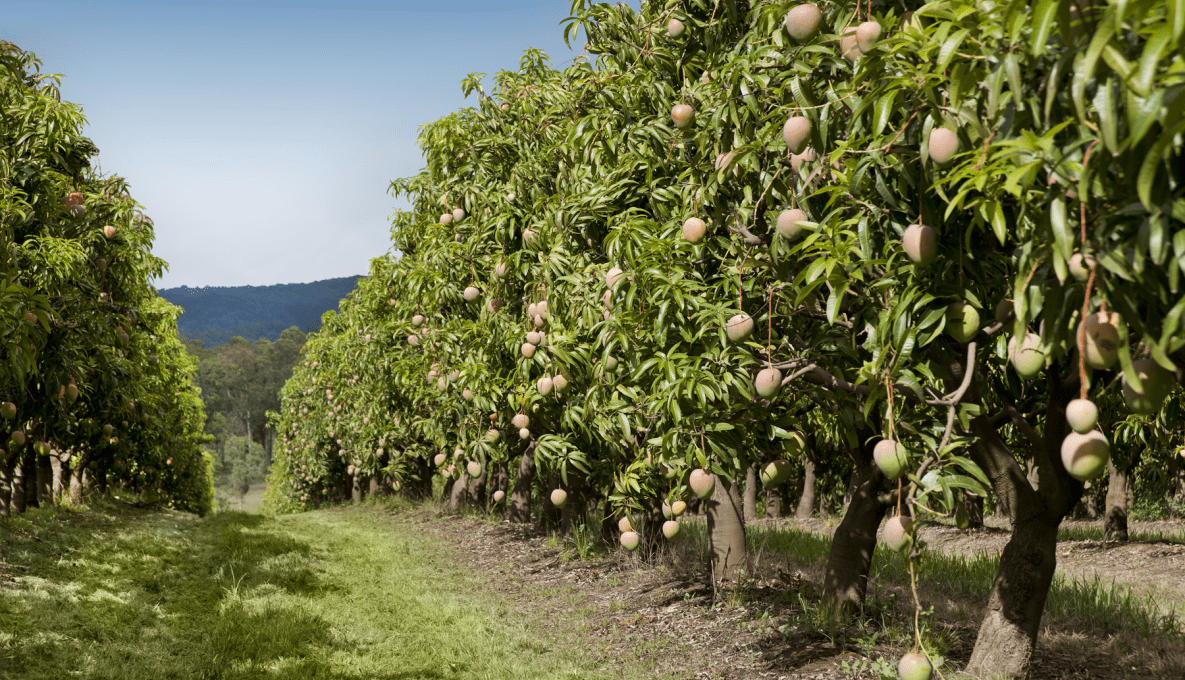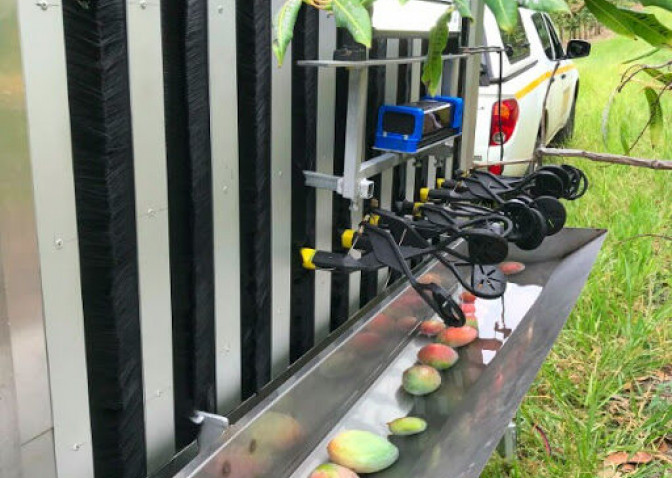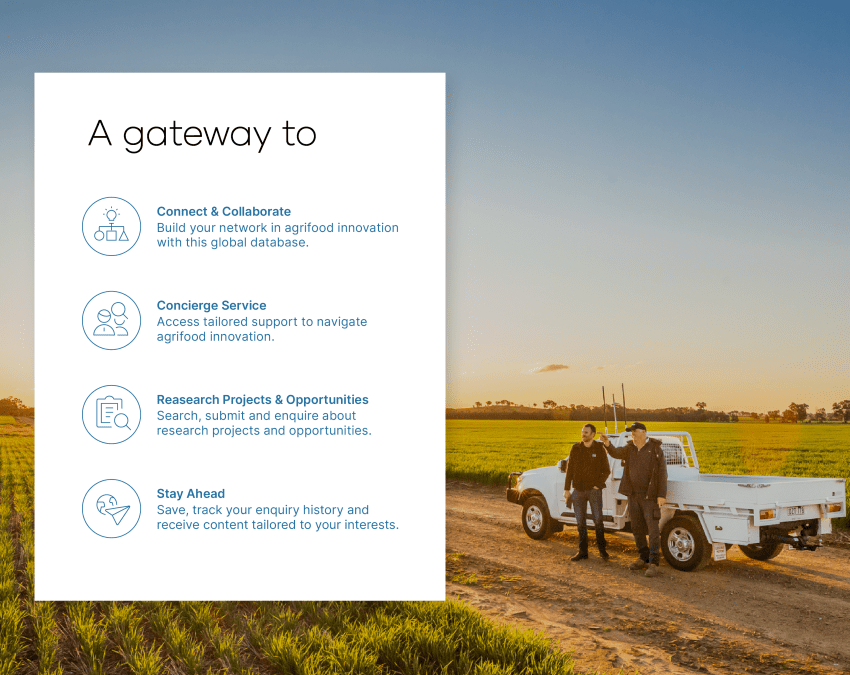
Multi-armed mango auto-harvester set to speed up picking by 90%
As it gets increasingly difficult to find reliable labour to pick acid-spurting mangoes in the tropical heat, a world-first automated harvester developed by Central Queensland University’s Fruitronics team and Hort Innovation, are now seeking commercial partnership from an agricultural equipment manufacturer.

Every year nine million mango trees are hand-harvested in Australia. Finding the labour to do that has always been a headache, especially since COVID-19 closed our borders.
But now a game-changing mango auto-harvester, built by the Fruitronics technology team at Central Queensland University (CQU) in collaboration with fruit growers and Hort Innovation, could provide some welcome pain relief.
Mounted on a trailer and pulled by a ute, the harvester is built in modules of four arms under the control of one camera with multiple modules possible.
If the camera detects fruit in the plane of one of the arms, it assigns that arm to move the measured distance, clamps onto the fruit, rotates 180 degrees, retracts and releases the fruit, explained CQU’s Professor Kerry Walsh.
Related organisations


The process takes five to six seconds and multiple arms can operate simultaneously. The harvester (seen in operation in this video) has already achieved 75% efficiency in automatically identifying and picking fruit and Professor Walsh is confident of improving that to over 90%.
Moving from this prototype stage to practical implementation, however, is a big step so CQU and Hort Innovation are now seeking commercial partnership from an agricultural equipment manufacturer to take the harvester to the next stage.
“Ideally, that partner would have some vision or electronics knowledge as well as mechanical capability so a fruit grader, spray or current harvest aid manufacturer would be ideal,” he said. “You also need a company that has some insight into the mango industry and the capability to follow up in terms of support and maintenance.
“What we need specifically is to implement it into a modified mango harvest aid so we have those arms picking and dropping onto a conveyor or trough with a spray system.”
Professor Walsh developed the harvester after many seasons spent in mango orchards, most recently working on a Multiscale Monitoring of Tropical Fruit Trees project led by UNE.
He and his team had previously delivered a near infrared spectroscopy (NIRS) measurement system to predict the ideal harvest time and were working on in-field machine vision systems to count and estimate fruit sizes before harvest.
CQUniversity's
Non-invasive sensor systems
Successful prototype the result of a leap of faith
“Then we talked to the growers and they said they didn’t just want to know numbers, they needed to know size as well to inform supermarkets,” explained Professor Walsh.
“We started playing around with time of flight cameras that enable you to get the distance between camera and fruit and judge the size within 4 mm and the next big leap was: ‘We can see the fruit, we know how far away it is, let’s add an arm on there to reach out and pick the thing.’
“It wasn’t written into the initial research grant. We just launched into it to give it a go given that the component technologies were there.”
The prototype harvester was so successful and funding is now being managed through Hort Innovation with support from the Government Department of Agriculture and Water Resources as part of its Rural R&D for Profit program.
“We’re working on decades of experience from the fruit packhouse and also drawing on our recent machine vision work so we’ve got a comfortable foundation. We’ve also seen other products go into commercial use so have an appreciation for commercial reality.”
While sophisticated robotic harvesters are used in some glasshouses, out in the orchards it’s a different matter. Every fruit is a different size, shape and softness. Some can be twisted off, but others have to be cut.
Mangoes, however, do suit mechanical harvest, said Professor Walsh. “They’re large and hang freely on a long stalk and on modern orchard designs they’re on the outside of the canopy.” The smaller trees in modern orchards also suit the auto harvester.
Designed to solve labour issues, cut costs and reduce health and safety concerns
Certainly, the prototype is an attractive proposition. It will help to solve labour issues, reduce health and safety concerns and cut costs. The unit can pick a typical tree side in six minutes and while the technology isn’t expensive and camera costs have come down, labour costs continue to rise – currently estimated at around 15 – 30cents per kilo or $20 million per annum in total, explained Professor Walsh. However, there are challenges.
The main one will be to integrate the auto harvester into harvest aids used in most mango orchards now. They reduce handling and maintain quality and prolong shelf life, using an elevator system to wash and rinse the acidic sap from mangoes, before placing them gently into bins and transporting them to packing sheds.
“Growers have particular ideas about what they want in a harvest aid so there needs to be an element of flexibility with that,” said Professor Walsh.
The design also needs to take into account that it might pay to have the harvester move between farms or districts rather than sit idle much of the year.
At present the Fruitronics team is working to improve parts and prepare for the next mango season – with the hope of joining forces with a commercial partner in preparation for the season.
If you are a machinery manufacturing and distribution company or an agronomy service company interested in new products and services please enquire about this commercial opprtunity here.
-crop-850x675.png)
Looking for engagement?
Showcase your commercialisation opportunity today.
Talk to our team to discuss how growAG. can connect your innovation to industry.
Have questions? Find answers to our most frequently asked questions on research projects, commercial opportunities, organisations and more.
